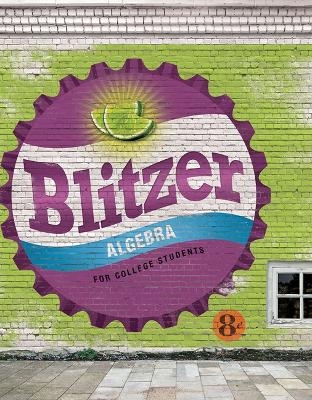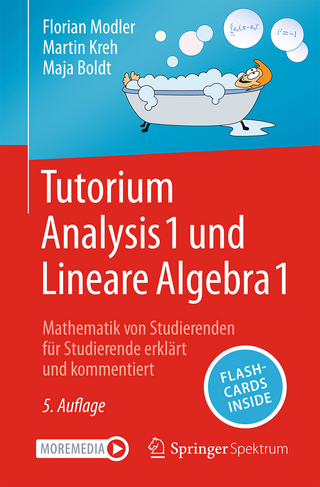
Algebra for College Students
Pearson (Verlag)
978-0-13-418084-7 (ISBN)
Bob Blitzer’s use of realistic applications instantly piques students’ curiosity about the presence of mathematical concepts in the world around them. These applications are apparent throughout the entire program–from his relatable examples, friendly writing style, and thought-provoking features in the textbook, to the enhanced digital resources in the MyMathLab course. Blitzer pulls from topics that are relevant to college students, often from pop culture and everyday life, to ensure that students will actually use their learning resources to achieve success. With an expansion of the series to now include a Developmental Math “all-in-one” text (with content spanning prealgebra through intermediate algebra), and with an enhanced media program accompanying this revision, developmental students at all levels will see how math applies to their daily lives and culture.
Also available with MyMathLab
MyMathLab® is an online homework, tutorial, and assessment program designed to work with this text to engage students and improve results. Within its structured environment, students practice what they learn, test their understanding, and pursue a personalized study plan that helps them absorb course material and understand difficult concepts.
Note: You are purchasing a standalone product; MyMathLab does not come packaged with this content. Students, if interested in purchasing this title with MyMathLab, ask your instructor for the correct package ISBN and Course ID. Instructors, contact your Pearson representative for more information.
If you would like to purchase both the physical text and MyMathLab, search for:
0134188411 / 9780134188416 * Algebra for College Students Access Card Package Package consists of:
0134180844 / 9780134180847 * Algebra for College Students
0321431308 / 9780321431301 * MyMathLab -- Glue-in Access Card
0321654064 / 9780321654069 * MyMathLab Inside Star Sticker
Bob Blitzer is a native of Manhattan and received a Bachelor of Arts degree with dual majors in mathematics and psychology (minor: English literature) from the City College of New York. His unusual combination of academic interests led him toward a Master of Arts in mathematics from the University of Miami and a doctorate in behavioral sciences from Nova University. Bob’s love for teaching mathematics was nourished for nearly 30 years at Miami Dade College, where he received numerous teaching awards, including Innovator of the Year from the League for Innovations in the Community College and an endowed chair based on excellence in the classroom. In addition to his Developmental Algebra Series, Bob has written textbooks covering college algebra, algebra and trigonometry, precalculus, and liberal arts mathematics, all published by Pearson Education. When not secluded in his Northern California writer’s cabin, Bob can be found hiking the beaches and trails of Point Reyes National Seashore, and tending to the chores required by his beloved entourage of horses, chickens, and irritable roosters.
1. Algebra, Mathematical Models, and Problem Solving
1.1 Algebraic Expressions, Real Numbers, and Interval Notation
1.2 Operations with Real Numbers and Simplifying Algebraic Expressions
1.3 Graphing Equations
1.4 Solving Linear Equations
Mid-Chapter Check Point Section 1.1—Section 1.4
1.5 Problem Solving and Using Formulas
1.6 Properties of Integral Exponents
1.7 Scientific Notation
Chapter 1 Group Project
Chapter 1 Summary
Chapter 1 Review Exercises
Chapter 1 Test
2. Functions and Linear Functions
2.1 Introduction to Functions
2.2 Graphs of Functions
2.3 The Algebra of Functions
Mid-Chapter Check Point Section 2.1—Section 2.3
2.4 Linear Functions and Slope
2.5 The Point-Slope Form of the Equation of a Line
Chapter 2 Group Project
Chapter 2 Summary
Chapter 2 Review Exercises
Chapter 2 Test
Cumulative Review Exercises (Chapters 1—2)
3. Systems of Linear Equations
3.1 Systems of Linear Equations in Two Variables
3.2 Problem Solving and Business Applications Using Systems of Equations
3.3 Systems of Linear Equations in Three Variables
Mid-Chapter Check Point Section 3.1—Section 3.3
3.4 Matrix Solutions to Linear Systems
3.5 Determinants and Cramer's Rule
Chapter 3 Group Project
Chapter 3 Summary
Chapter 3 Review Exercises
Chapter 3 Test
Cumulative Review Exercises (Chapters 1—3)
4. Inequalities and Problem Solving
4.1 Solving Linear Inequalities
4.2 Compound Inequalities
4.3 Equations and Inequalities Involving Absolute Value
Mid-Chapter Check Point Section 4.1—Section 4.3
4.4 Linear Inequalities in Two Variables
4.5 Linear Programming
Chapter 4 Group Project
Chapter 4 Summary
Chapter 4 Review Exercises
Chapter 4 Test
Cumulative Review Exercises (Chapters 1—4)
5. Polynomials, Polynomial Functions, and Factoring
5.1 Introduction to Polynomials and Polynomial Functions
5.2 Multiplication of Polynomials
5.3 Greatest Common Factors and Factoring By Grouping
5.4 Factoring Trinomials
Mid-Chapter Check Point Section 5.1—Section 5.4
5.5 Factoring Special Forms
5.6 A General Factoring Strategy
5.7 Polynomial Equations and Their Applications
Chapter 5 Group Project
Chapter 5 Summary
Chapter 5 Review Exercises
Chapter 5 Test
Cumulative Review Exercises (Chapters 1—5)
6. Rational Expressions, Functions, and Equations
6.1 Rational Expressions and Functions: Multiplying and Dividing
6.2 Adding and Subtracting Rational Expressions
6.3 Complex Rational Expressions
6.4 Division of Polynomials
Mid-Chapter Check Point Section 6.1—Section 6.4
6.5 Synthetic Division and the Remainder Theorem
6.6 Rational Equations
6.7 Formulas and Applications of Rational Equations
6.8 Modeling Using Variation
Chapter 6 Group Project
Chapter 6 Summary
Chapter 6 Review Exercises
Chapter 6 Test
Cumulative Review Exercises (Chapters 1—6)
7. Radicals, Radical Functions, and Rational Exponents
7.1 Radical Expressions and Functions
7.2 Rational Exponents
7.3 Multiplying and Simplifying Radical Expressions
7.4 Adding, Subtracting, and Dividing Radical Expressions
Mid-Chapter Check Point Section 7.1—Section 7.4
7.5 Multiplying with More Than One Term and Rationalizing Denominators
7.6 Radical Equations
7.7 Complex Numbers
Chapter 7 Group Project
Chapter 7 Summary
Chapter 7 Review Exercises
Chapter 7 Test
Cumulative Review Exercises (Chapters 1—7)
8. Quadratic Equations and Functions
8.1 The Square Root Property and Completing the Square
8.2 The Quadratic Formula
8.3 Quadratic Functions and Their Graphs
Mid-Chapter Check Point Section 8.1—Section 8.3
8.4 Equations Quadratic in Form
8.5 Polynomial and Rational Inequalities
Chapter 8 Group Project
Chapter 8 Summary
Chapter 8 Review Exercises
Chapter 8 Test
Cumulative Review Exercises (Chapters 1—8)
9. Exponential and Logarithmic Functions
9.1 Exponential Functions
9.2 Composite and Inverse Functions
9.3 Logarithmic Functions
9.4 Properties of Logarithms
Mid-Chapter Check Point Section 9.1—Section 9.4
9.5 Exponential and Logarithmic Equations
9.6 Exponential Growth and Decay; Modeling Data
Chapter 9 Group Project
Chapter 9 Summary
Chapter 9 Review Exercises
Chapter 9 Test
Cumulative Review Exercises (Chapters 1—9)
10. Conic Sections and Systems of Nonlinear Equations
10.1 Distance and Midpoint Formulas; Circles
10.2 The Ellipse
10.3 The Hyperbola
Mid-Chapter Check Point Section 10.1—Section 10.3
10.4 The Parabola; Identifying Conic Sections
10.5 Systems of Nonlinear Equations in Two Variables
Chapter 10 Group Project
Chapter 10 Summary
Chapter 10 Review Exercises
Chapter 10 Test
Cumulative Review Exercises (Chapters 1—10)
11. More on Polynomial and Rational Functions
11.1 Polynomial Functions and Their Graphs
11.2 Zeros of Polynomial Functions
Mid-Chapter Check Point Section 11.1—Section 11.2
11.3 Rational Functions and Their Graphs
Chapter 11 Group Project
Chapter 11 Summary
Chapter 11 Review Exercises
Chapter 11 Test
Cumulative Review Exercises (Chapters 1—11)
12. Sequences, Induction, and Probability
12.1 Sequences and Summation Notation
12.2 Arithmetic Sequences
12.3 Geometric Sequences and Series
Mid-Chapter Check Point Section 12.1—Section 12.3
12.4 The Binomial Theorem
12.5 Mathematical Induction
12.6 Counting Principles, Permutations, and Combinations
12.7 Probability
Chapter 12 Group Project
Chapter 12 Summary
Chapter 12 Review Exercises
Chapter 12 Test
Cumulative Review Exercises (Chapters 1—12)
Appendix
Where Did That Come From? Selected Proofs
| Erscheinungsdatum | 10.07.2016 |
|---|---|
| Sprache | englisch |
| Maße | 221 x 277 mm |
| Gewicht | 2145 g |
| Themenwelt | Mathematik / Informatik ► Mathematik ► Algebra |
| ISBN-10 | 0-13-418084-4 / 0134180844 |
| ISBN-13 | 978-0-13-418084-7 / 9780134180847 |
| Zustand | Neuware |
| Informationen gemäß Produktsicherheitsverordnung (GPSR) | |
| Haben Sie eine Frage zum Produkt? |
aus dem Bereich


